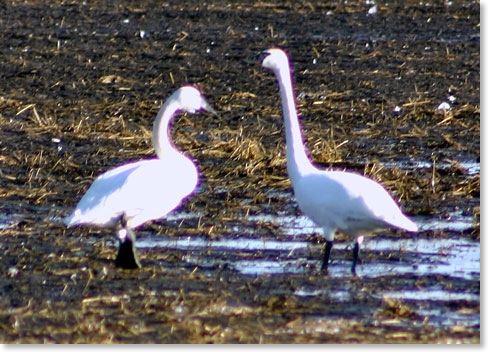
Swans
Tisdale - Thursday, April 5, 2012

Unfortunately, the battery on the Canon Rebel with its telephoto lens was not up to the task so the pictures you see the rest of the pictures on this page were taken on Wednesday about eight to ten miles south of Tisdale.


Even with that few numbers of individuals American hunters still shoot thousands each year legally while almost double those killed legally are killed by poachers. The other problem is bird shot itself is made of lead and young birds will die from ingesting the little lead balls.
With these images the physical size is the main factor in determining which is which and at a distance it is really just a guess. Trumpeters are slightly larger with a male’s wing span almost ten feet with the Tundra (Whistler) being about 82 inches. In both cases these are big birds. A large male Trumpeter from the tip of his bill to the tip of his tale is about six feet long.


There are two populations of what used to be called Whistler swans, now referred to as Tundra swans, the whistler name came from the sound of their flight not their voices. Surprising the two populations in North America seem to be balancing out and perhaps even gaining a bit in numbers.


I was truly impressed with the way these birds gracefully take to the air and with slow wing beats move along at surprising speed. Not at all like the flight of Niska (Canada geese). As a group of birds the white arctic geese are really long distance travellers and have been known to be cruising along as high as 27,000 feet, just below normal cruise altitude for a Boeing.
The Tundra and Trumpeter swans live long lives from ten to twenty-five years. The take just over three months to go from egg to flying bird, take about three years to grow to reproductive age then spend a year going steady before they mate for life. If one of the partners dies the other lives the rest of their life as a widow or widower.
